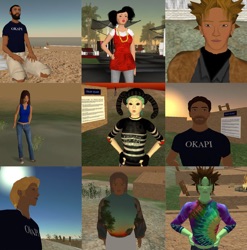About Okapi Island

About Okapi Island
Remixing Çatalhöyük Day at Okapi Island. Nov 2007

January 2008
Okapi Island Image Gallery
Publications and Interviews about Okapi Island
Recent News at Okapi Island
-
•New buildings created
-
•Freshman Seminar creates Machinimas
Other links
-
•Middle Savagery (Colleen Morgan) blog
-
•Keep in touch by the Okapi Island Blog

Remixing Çatalhöyük in Second Life
by Ruth Tringham and Noah Wittman
How do we share and communicate a sense of place to another person or a larger audience – academics, professional archaeologists, teachers, lifelong learners, or journalists – when this place is physically remote or even inaccessible without a large budget? How do we express the senses of a place that in the past was alive with people, events and meaning, and now seems dead and empty?
Literature, poetry, art, photography and film have been the traditional media through which to respond to these challenges. More recently, Virtual Reality immersed audiences in 3-D models of places. But the most enticing environments - multiplayer computer games – where the user wanders round places with others exploring in depth were beyond the reach of archaeologists. This has all changed with the development of Second Life.
Like a computer game, Second life is a multiplayer online 3-D virtual world, but one entirely constructed by its residents, who now number more than eight million. Second Life residents, each representing a real-word user, construct their own representations, called avatars, and explore, build, socialize and form their own communities. The Second Life platform is developed and maintained by Linden Labs, a commercial company, but is free for anyone to join and participate, although they do charge for land ownership.
As archaeologists and educators, we see virtual worlds as an opportunity to explore alternative approaches to education and civic engagement by providing a space for the public to engage in dialogue with archaeologists and participate in the interpretation and communication of archaeological research.
With this in mind, a team of University of California, Berkeley students, archaeologists, and media specialists led by Noah Wittman and Ruth Tringham in early 2007 began using Second Life to develop a virtual reconstruction of Çatalhöyük, a Neolithic settlement mound located in present-day Turkey. This project was conceived as complementary to a concurrent project - online exhibition and resource “Remixing Çatalhöyük”. We purchased land (thanks to David Greenbaum of the UC Berkeley IST) and named it Okapi Island (after our sponsor, the Open Knowledge and the Public Interest program). The team meets face-to-face every week in our computer laboratory and “in-world” on our virtual property in Second Life.
Okapi Island is modeled after the East Mound at Çatalhöyük as it exists today, and as it may have looked in the past. We used archaeological evidence and a bit of poetic license to reconstruct excavation areas and multimedia exhibits featuring the investigations and discoveries of archaeologists at Catalhoyuk. Our goal was to provide a window into the work of real archaeologists as an alternative to the theme-park narrative commonly presented in popular media.
There are three dimensions to Okapi Island. Çatalhöyük Today focuses on the life and work of the members of the Çatalhöyük Research Project and their neighbors in the Turkish countryside. Inside the Berkeley Archaeologists at Çatalhöyük (BACH) tent, visitors can watch videos of archaeologists at work digging, discussing and demonstrating. Additionally, video-walks recorded across the East Mound are mirrored on Okapi Island, so that a user can watch the “real” walk as sh/e walks across the site. There are also opportunities to speak with archaeologists in real time on Okapi Island.
Çatalhöyük Past explores the use of Second Life as a platform for building and sharing diverse representations of Neolithic Çatalhöyük. In the South area, site of the original 1960s excavation by James Mellaart, we have presented the traditional but, for some, problematic representation of Catalhoyk as a tight cluster of homes, entered by ladder from the roof. Our goal is to open this visualization to critique rather than uncritical immersion.
Çatalhöyük Mystery gives residents the ability to use their imaginations and available evidence to think about the unexplored parts of the mound. This is as an opportunity to create a learning platform for discussing methods of field enquiry, including excavation, etc. Visitors are encouraged to participate in the construction of the island and interpretation of research data by using the Sandbox (temporary building area) or leaving comments and artwork on the Graffiti Wall.
The Museum provides orientation for new visitors and a video exhibition. The island also features a scavenger hunt and a Webcast area for streaming video of live events. Extensive signage will be in Turkish and English. We have planned a number of events to encourage visits and participation in Okapi Island. For example on November 28, 2007, there were guided tours, a streamed lecture by Ruth Tringham, and a film festival. Many other such events are planned in the near future. Other events have been organized in subsequent years. more....
The Okapi Island project is on-going and is currently led by Ruth Tringham and UC Berkeley doctoral student Colleen Morgan. Undergraduate apprentices participate in the project each semester and it is also incorporated into a number of formal and less formal courses. more,,,,,



